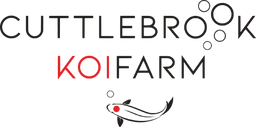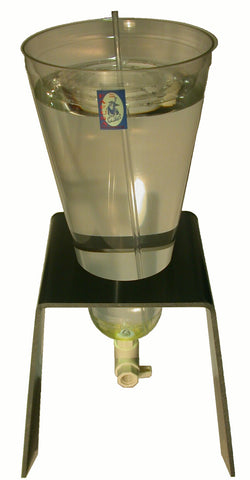This article was first written for and published by Koi Carp Magazine in 2009 (edited 2018)
- Don’t try to rear too many fry as overstocking can lead to poor water quality and cannibalism. Only keep enough fry for the area you have to grow them in – a 2.5metre x 2 metre tank has a surface area of 5 metres squared, so a maximum of 500 to 750 fish can be raised in an environment of this size – a reasonable number of fry for a hobbyist to deal with. If you have too many live eggs then you could remove the spawning ropes, with the eggs attached, before they hatch. (You could share some with friends if you like – transport them in the same way as you would adult fish, in a plastic bag with water and air/oxygen.) That way you will only rear the fry hatched from the eggs stuck to the sides or base of the spawning tank. The other way to control the number that you grow on is to hatch the fry, drain down the tank, catch the fry and then count them, keeping only the number that you think you can successfully raise.
- Filtering the water is always a problem with fry and is labour intensive in a tank environment. A sponge on the end of a submersible pump makes an effective screen to prevent the fry from being sucked up into the pump but it will need to be cleaned daily. The size of the filter is dependent on the number of fry and the size of the tank. (We don’t use filters as we grow our fry in a mud pond which has its own ecosystem that provides first food naturally for the fry.) It is essential that any waste products are removed from the floor of the tank to stop the waste breaking down and polluting the water. It takes a few days for the fry to become accustomed to powdered food as they aren’t used to it yet and need to acquire a taste for it. For this reason you will find that there will be quite a lot of uneaten food in the tank but after two weeks the fry should leave less waste. A good sign that they are feeding well is the appearance of large fat tummies.
- Finding the right food for fry is tricky when you are only looking for a small amount and at Cuttlebrook Koi Farm we buy ours in 20 kg sacks – way too much for the hobbyist! (Update 14/05/2018: We now sell small tubs of the fry food that we feed to our own fry. This is available for sale on our website).In the mud pond, Koi fry feed on Rotifers and Paramecium as a first food and these are around 100 – 150 microns in size. 100 micron food powder should be sprinkled on the surface 3 to 5 times a day for one week then, as the fry grow, the food size should be increased so that by the time they are 2.5cm long they are on 0.8 to 1.2 mm medium crumb diet. Alternatively, Artemia, or brine shrimp, are a good source of live first food and are nutritious and high in Omega 3 but aren’t as convenient as powdered fry food. You can breed your own Artemia which can be hatched from cysts in a special incubator in which salt water and warmth encourage the shrimps to hatch. Once hatched, they are fed to the fry.

4. Diseases are always a worry and identification early is a must for fry. Any dead fish are usually a sign of malnutrition or disease. Koi fry are too small to take a skin scrape, so you will have to place a sickly looking fish on a microscope slide with a drop of water and, using a microscope, look at the tail first as this is where you will see the first sign of parasites. Treating diseases in fry is the same as for adult fish – identify the problem first using a microscope and only treat when you are sure that you know which parasite or parasites you are dealing with. Only treat if you have to. A good bio-security policy, making sure the parents are clean before spawning and that no main pond water is used in the fry tank will all help stop the fry catching diseases.
5. Grading your fry and selecting those that you are going to grow on is very important. It is a job that is time consuming but which must be done carefully to ensure that fry are not unduly stressed. At Cuttlebrook, we have a dedicated area and equipment that we use for carrying out selection as we spend a considerable amount of time over the spring and summer months on this particularly important task. In principle, what we have is a tray (you could use a tub) of the same water that the fry are held in – the keepers go into a holding net suspended in the tray (using a holding net makes it easier to catch the fry again afterwards and therefore less stressful for them) and those that we don’t keep go into a separate holding tank. We use a pan net to scoop a few fry up so that we can look at them closely and a small selection spoon (about the same size as the fry) to select individual fry that we want to keep. Once we have caught up and selected through all the baby Koi that we have in a particular pond, we put the keepers back in the pond. (Those that we don’t want to keep are sold.) Make sure that you provide plenty of aeration for your baby Koi, particularly in the warmer summer months as they can quickly suffer from oxygen deprivation when held for any length of time in a confined space and make sure the water doesn’t warm up too much.
6. The fry should grow to 20mm – 25 mm after 4 to 5 weeks after swim up and this is when selection MUST take place. If the best are not selected for further growth and the deformed, weak and ugly removed, then the growth and health of the population as a whole will suffer. At this stage only 10 fish per metre squared should be kept. (Under no circumstances should any unwanted fish be released into the wild – this is illegal and homes for these fish must be sought at the earliest opportunity.) First selection takes place when the baby Koi are around 2.5 mm in length and you will find that even if you bred a specific variety, the chances are, you will not recognise many of the fry as being the variety that you chose – this is the reason that selection must be carried out and you must choose to keep only the best representations that you can find of the variety that you chose. When selecting Sanke, for example, you will find all of the following variations: Benigoi (red), Shiro Muji (white), Aka Bekko (red with black pattern) Shiro Bekko (white with black pattern), Kohaku (white with red pattern) and Sanke (white with both red and black pattern). The fastest growing are often the Benigoi as these are closest genetically to the carp that Nishikigoi originate from. If you grow these on it is likely that they will quickly outgrow their siblings and will soon begin to eat them! Here are three pictures of the same group of Sanke, bred in 2006. The first picture shows them before selection.
Sanke fry 4-5 weeks old before first selection
The second picture, after selection, shows some of the few that were chosen to be grown on for a further 4-5 weeks.
They are very pale and the red pattern in particular is hard to spot. At this stage you should be looking for good body shape (not too fat or too thin), no deformities and good skin quality. Try to find as balanced a pattern as you can. Don’t be put off that the hi (red) is very pale as this is normal in young Koi and will become stronger as the Koi ages and its skin thickens.
7. Second selection takes place 4-5 weeks later when the Koi are around 5 – 7.5 cm in length. The Sanke in this picture are from the same spawning as the previous picture and you can see how much they have changed in just a short time.

You are still looking for the same qualities at this size and, as the Koi are bigger, those qualities are much easier to spot.
8. Selection takes place throughout the life of a Koi and happens each time it is harvested. This picture shows a Sanke, from the spawning in 2006 pictured earlier, coming out of the mud pond in Autumn 2008. As you can see, the hi has become stronger and the sumi has developed making this Koi a good example of its variety. It takes time for Koi to develop and it shows why correct early selection is so important.
9. At some point you may wish to introduce your baby Koi to your main pond. Koi generally eat anything that fit into their mouths and if your adult Koi come across a baby Koi, the chances are they might just see it as a tasty snack! For this reason I would advise that you don’t introduce anything smaller than will fit into the mouth of the largest Koi in your pond.
10. When looking after little fish along with big ones you may find that the smaller fish are, not surprisingly, a little intimidated by the larger Koi and that they will follow their instincts and do their best to hide from them. This could mean that you don’t see very much of them but do your best to keep an eye on them and make sure that whatever food you feed, that it is a suitable size for your smallest Koi.







